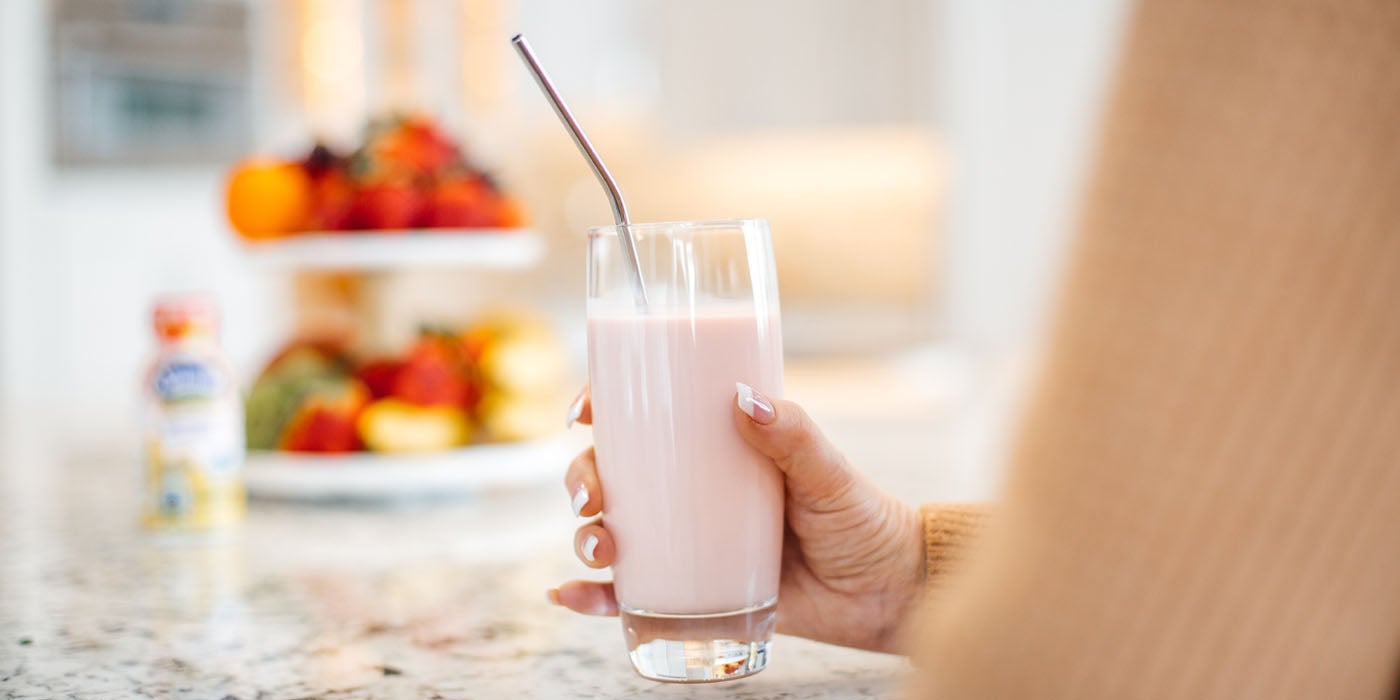What Makes a Good Diabetes Nutrition Shake?
Look at these 7 items when choosing a diabetes snack or meal replacement shake.
September 21, 2021
While browsing the grocery store or pharmacy lately, you may have noticed the increasing availability of nutrition shakes, including nutrition shakes made specially for people with diabetes. In fact, more and more people have chosen to start including a diabetes nutrition shake in their daily meal plan over the past year.1 This is not surprising as many people may be burnt out on cooking or are looking for quick meals and snacks to grab on the go. With a nutrition shake, all you have to do is chill, shake, and drink it!
A key benefit to diabetes nutrition shakes is that they can serve as meal or snack replacements. Whether you are trying to prevent diabetes or manage it, skipping meals or snacks should be avoided. Many people think skipping meals or snacks can jumpstart weight loss, but it can actually result in the opposite! Research shows that skipping breakfast specifically is associated with overweight/obesity, which is a risk factor for diabetes and diabetes complications.2
It can also be tempting to skip a meal or snack when you don’t actually “feel” hungry, but do not fall into this habit. If you take insulin or a sulfonylurea (e.g. glimepiride) for your diabetes, missing a meal or snack can be devastating as this may lead to severe hypoglycemia (or low blood sugar). A diabetes nutrition shake with the right blend of nutrients can help keep blood sugars stable and thereby help prevent hypoglycemia. Plus, it’s a great meal or snack option compared to the less healthy choices that can lead to hyperglycemia (or high blood sugar)!
So what makes a good diabetes nutrition shake? Here are the 7 items to look for when shake shopping:
#1: Calories
The amount of calories to aim for really depends on how many calories you are aiming to consume in a day, which varies person to person. However, a good rule-of-thumb is that if you plan to use a shake as a snack replacement, choose one that contains 200 calories or less. That way, if you later decide to use it as a meal replacement, you have room to add something to the meal, such as a piece of fresh fruit.
#2: Fat
For decades, fat was considered the villain of the nutrition storybook. However, more advanced research has shown that a healthy balance of fats in our diet is more important than striving for an overall low-fat diet.3 This means you should not just consider the amount of fat you are eating but consider the types of fat you are eating as well. Look for a nutrition shake that contains mostly monounsaturated and polyunsaturated fats—these are healthy fats, meaning they are heart-protective. You can find the types of fat in a shake on the Nutrition Facts label under “Total Fat.” See the Nutrition Facts label for a Splenda® Diabetes Care shake below for an example.
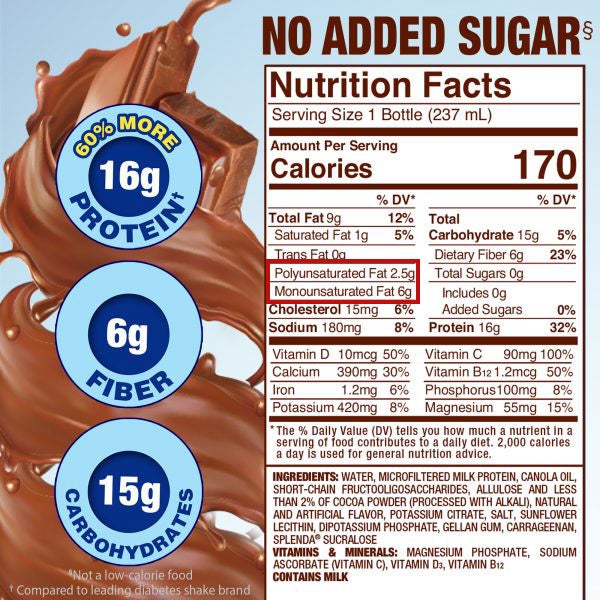
#3: Carbohydrates
While there is no magic number of carbs to aim for per meal or snack (this varies person to person), there are typical recommendations for people with diabetes. If you plan to use a shake as a snack replacement, aim for one that contains 15-30 grams carb per serving. Depending on your diabetes meal plan, you may be aiming anywhere from 30-75 grams carb per meal. Therefore, if you choose to use the shake as a meal replacement, simply pair it with another carb food, such as a piece of fresh fruit. This will add not only carb to your meal but also fiber, vitamins, and minerals.
#4: Fiber
Daily fiber recommendations vary based on age and gender with the range being 21-38 grams per day. Most Americans only meet about half their recommendation each day.3 A good diabetes nutrition shake should make a significant contribution to your fiber needs. Fiber is important for people with diabetes because it can help slow down the absorption of sugar and improve blood sugar levels. Each Splenda Diabetes Care Shake contains 6 grams of dietary fiber, which is the equivalent of eating almost 9 cups of raw spinach in terms of fiber!
#5: Protein
Your body uses protein to make and repair cells, so it is very important to get enough of it in your diet. The minimum recommended amount of protein per day is 46 grams for adult women and 56 grams for adult men.4 Typically, one ounce of a protein food (such as meat or cheese) is equivalent to 7 grams of protein. An ideal nutrition shake contains a 2-3 ounce protein equivalent (or 14-21 grams protein) per serving.
#6: Vitamins and Minerals
Vitamins and minerals are essential for good health, but the amount we need of each one of them varies. Americans are not getting enough of several vitamins and minerals, including vitamin C, vitamin D, calcium, magnesium, and potassium.3 All these nutrients are included in Splenda Diabetes Care Shakes! Additionally, Splenda Diabetes Care Shakes include vitamin B12, a nutrient that is especially important for people with diabetes. Vitamin B12 deficiency is very common among people with diabetes and can contribute to dementia and nerve damage.5
#7: Flavor and Taste
Of course the nutrients in a diabetes nutrition care shake are important, but we cannot forget about flavor and taste! Splenda Diabetes Care Shakes contain a high-quality micro-filtered milk protein and only the essential nutrients to deliver a clean-tasting, deliciously smooth, and creamy product. Splenda Diabetes Care Shakes come in three delicious flavors: Milk Chocolate, French Vanilla, and Strawberry Banana.
Summary: There are many choices when it comes to diabetes nutrition shakes, but there are key differences between them. Choose one that meets the above nutrient recommendations, but make sure it has a yummy flavor and taste that you will actually enjoy! Click below to find out more about Splenda Diabetes Care Shakes.
Written by Holly Moran, MS, RDN, LD, CDCES and member of the Splenda Healthcare team.
Try Splenda Diabetes Care Shakes
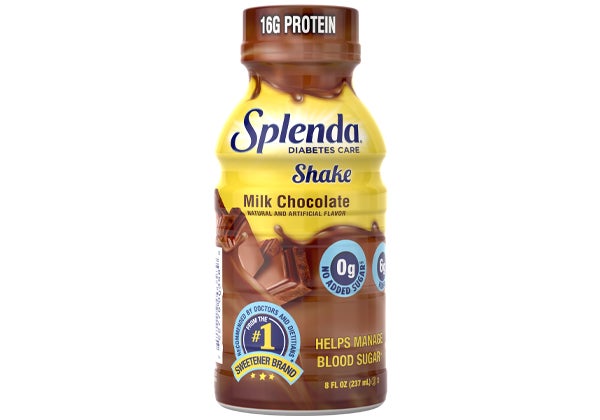
Splenda® Milk Chocolate Diabetes Care Shakes
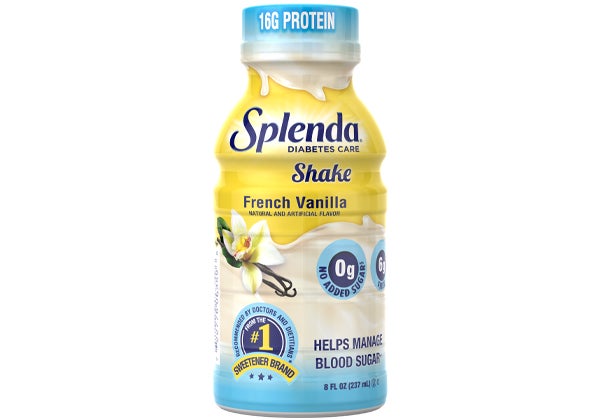
Splenda® French Vanilla Diabetes Care Shakes
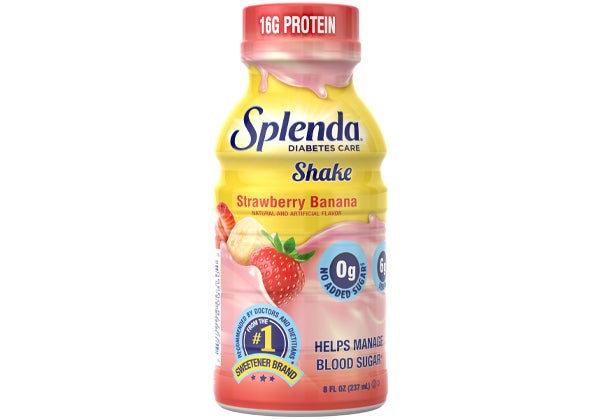
Splenda® Strawberry Banana Diabetes Shakes
1 Nielson AOD – Total USxAOD – 52 weeks ending 07/03/2021 2 Ma, X., Chen, Q., Pu, Y., Guo, M., Jiang, Z., Huang, W., Long, Y., & Xu, Y. (2020). Skipping breakfast is associated with overweight and obesity: A systematic review and meta-analysis. Obesity research & clinical practice, 14(1), 1–8. https://doi.org/10.1016/j.orcp.2019.12.002 3 Duyff, R. L. (2017). Academy of Nutrition and Dietetics complete food and nutrition guide (5th ed.). Houghton Mifflin Harcourt. 4 U.S. Department of Agriculture and U.S. Department of Health and Human Services. Dietary Guidelines for Americans, 2020-2025. 9th Edition. December 2020. 5 Kibirige, D., & Mwebaze, R. (2013). Vitamin B12 deficiency among patients with diabetes mellitus: is routine screening and supplementation justified?. Journal of diabetes and metabolic disorders, 12(1), 17. https://doi.org/10.1186/2251-6581-12-17

